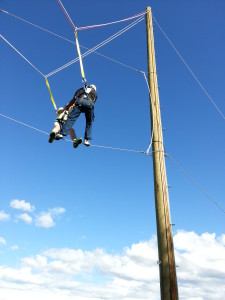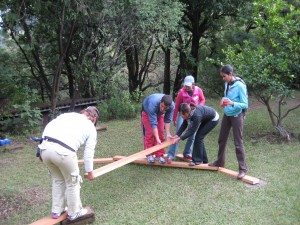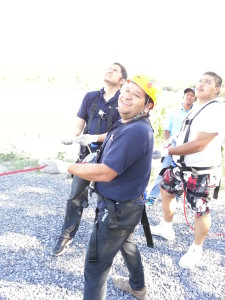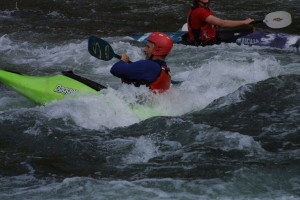If you are considering an experiential learning program for your team or to accelerate learning in a particular area, here are a few basic facts you should know:
[one_fifth]
High Climbing Events High events get the heart pumping, push participants “outside their comfort zone” and bring teams together for a common purpose like no other events. They require intense professional equipment and must be designed and built according to Association of Challenge Course Technology specifications (U.S.A.). A well designed course and program will accomodate all physical abilities placing non-climbing particpants in important observation roles. Medical screening and liability waivers are necessary.
[/one_fifth] [one_fifth]
Low Activities and Portables Activities on the ground are very effective, may have high physical risk (trust fall) or low physical risk (team juggle) depending on the activity. The “lows” are known for their ease of delivery and high impact for team learning. The more experienced facilitators will tell you that the team learning and leadership competencies are more powerfully felt and remembered in the so call “low” elements or activities. This is because the physical presence of you and your team is more intimate and the emotional content more intense. There is no doubt that high climbing events get the heart pumping, but the low events make the heart more connected and involved.
[/one_fifth] [one_fifth]
Dynamic Belay Systems vs. Static Belay Towers So called “Pecos River” style courses are designed to maximize team involvement and team responsibility. Unlike towers, zip lines and traverses, dynamic belay requires the team to manage the safety ropes and therefor higher levels of trust and communication must be developed before the participants can climb. I am not a fan of static belay systems that attach each particpant to their own fixed belay cable and their safety is not dependent on the team. At SFLC our course is dynamic belay “Pecos Style” to maximize team development.
[/one_fifth] [one_fifth]
Adventure Learning Adventure programs take place at remote sites, often involve hiking or rafting down a river, rappeling off a cliff or other exciting challenges. Overnight camping is often included and part of the wilderness experience. Because they cause excess environmental damage, we do not use motos, rappel down cascadas or enter wilderness areas with motorozed vehicles. Our adventure programs are specifically designed for each group. The logistics and planning are significant and detailed to insure safety, enjoyment and appropriate challenges.
Leadership Retreats. The word “retreat” doesn’t translate well into spanish, perhaps “refugio” is best. There is a turning inward that occurs in retreats. There is more silence, more space and more personal growth in a retreat. Batteries get recharged, professional and life goals are brought into alignment and a mindful perspective is practiced. Teams can go on a reatreat, they can be fun and energizing. But the deeper value of a retreat is in the silence, in the reflective time each particpant has to listen to their inner voice.
Highly trained facilitators insure the emotional and physical safety of the participants. Significant experience with hundreds if not thousands of participants gives professional facilitators the tools to help their groups trust each other, communicate honestly and openly and learn to work together to achieve their goals. In a retreat atmosphere the emotional risks are higher and so creating a trusting environment is crucial to success.
[/one_fifth_last]
You should always ask about the physical safety record of the company you are considering to hire. For longitudinal safety studies and statistics go to our safety record page.



